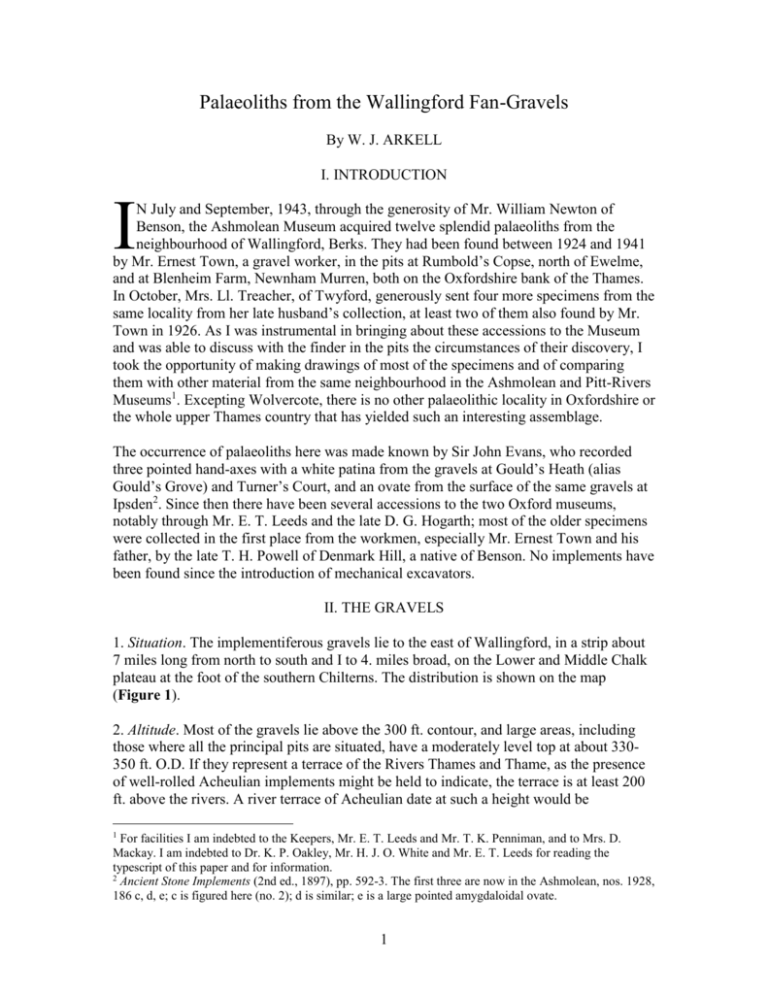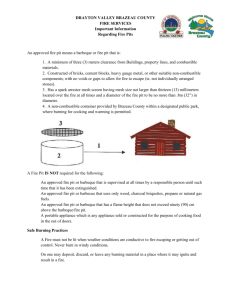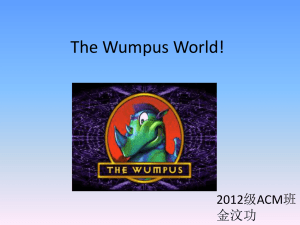Palaeoliths from the Wallingford Fan-Gravels
advertisement

Palaeoliths from the Wallingford Fan-Gravels
By W. J. ARKELL
I. INTRODUCTION
I
N July and September, 1943, through the generosity of Mr. William Newton of
Benson, the Ashmolean Museum acquired twelve splendid palaeoliths from the
neighbourhood of Wallingford, Berks. They had been found between 1924 and 1941
by Mr. Ernest Town, a gravel worker, in the pits at Rumbold’s Copse, north of Ewelme,
and at Blenheim Farm, Newnham Murren, both on the Oxfordshire bank of the Thames.
In October, Mrs. Ll. Treacher, of Twyford, generously sent four more specimens from the
same locality from her late husband’s collection, at least two of them also found by Mr.
Town in 1926. As I was instrumental in bringing about these accessions to the Museum
and was able to discuss with the finder in the pits the circumstances of their discovery, I
took the opportunity of making drawings of most of the specimens and of comparing
them with other material from the same neighbourhood in the Ashmolean and Pitt-Rivers
Museums1. Excepting Wolvercote, there is no other palaeolithic locality in Oxfordshire or
the whole upper Thames country that has yielded such an interesting assemblage.
The occurrence of palaeoliths here was made known by Sir John Evans, who recorded
three pointed hand-axes with a white patina from the gravels at Gould’s Heath (alias
Gould’s Grove) and Turner’s Court, and an ovate from the surface of the same gravels at
Ipsden2. Since then there have been several accessions to the two Oxford museums,
notably through Mr. E. T. Leeds and the late D. G. Hogarth; most of the older specimens
were collected in the first place from the workmen, especially Mr. Ernest Town and his
father, by the late T. H. Powell of Denmark Hill, a native of Benson. No implements have
been found since the introduction of mechanical excavators.
II. THE GRAVELS
1. Situation. The implementiferous gravels lie to the east of Wallingford, in a strip about
7 miles long from north to south and I to 4. miles broad, on the Lower and Middle Chalk
plateau at the foot of the southern Chilterns. The distribution is shown on the map
(Figure 1).
2. Altitude. Most of the gravels lie above the 300 ft. contour, and large areas, including
those where all the principal pits are situated, have a moderately level top at about 330350 ft. O.D. If they represent a terrace of the Rivers Thames and Thame, as the presence
of well-rolled Acheulian implements might be held to indicate, the terrace is at least 200
ft. above the rivers. A river terrace of Acheulian date at such a height would be
1
For facilities I am indebted to the Keepers, Mr. E. T. Leeds and Mr. T. K. Penniman, and to Mrs. D.
Mackay. I am indebted to Dr. K. P. Oakley, Mr. H. J. O. White and Mr. E. T. Leeds for reading the
typescript of this paper and for information.
2
Ancient Stone Implements (2nd ed., 1897), pp. 592-3. The first three are now in the Ashmolean, nos. 1928,
186 c, d, e; c is figured here (no. 2); d is similar; e is a large pointed amygdaloidal ovate.
1
W. J. ARKELL
unprecedented. In some places, moreover, as at Potter’s Farm, near the Henley Road, and
at Britwell House, the surface of the gravel slopes gradually up to 430 ft. O.D., while in
other places it slopes down, as at Primrose Hill, to 240 ft. O.D., which is only about 80 ft.
above the River Thame.
3. Relation to the escarpment. The general parallelism of the gravels to the escarpment is
obvious. At the two places where they reach their greatest elevation of 430 ft. they appear
to be banked against it3. In front of some of the biggest coombes, as at Turner’s Court,
below Nuffield, the gravel is truncated at the back by erosion and a tongue of it is left
pointing up the coombe.
4. Sub-surface relief. Apart from the general slope away from the escarpment and a
terrace-like arrangement which could be due to the Lower Chalk subsidiary escarpment,
the disposition of the gravels indicates that they choke an earlier topography. The main
outcrop, in which lie the important pits at Turner’s Court, Blenheim Farm, and Gould’s
Grove, fills a shallow valley running north-south and opening out south-west to the
Thames between North and South Stoke4.
5. Thickness and composition. The proved thickness of the gravel is locally up to 25 ft.
The Blenheim Farm and Gould’s Grove pits both show faces 15 ft. deep. The Survey
classified it as Angular Flint Gravel, a subdivision of their Plateau Gravel. The material is
overwhelmingly angular flint, in a matrix of quartz sand or loam derived from the
Reading Beds. Battered beach pebbles and sarsen are common, both also derived from
the Reading Beds. I have seen sarsens up to 2 ½ ft. in diameter near the base at Blenheim
Farm, and Mr. Ernest Town told me he once saw one there about 6 ft. square. Chalk is
confined to the lower parts, as described below. Northern Drift pebbles occur rarely.
6. Fauna. The only animal remains recorded are a tooth of mammoth near Britwell House
and a horn of stag near Blenheim Farm. Mr. Newton had a rolled fragment of Elephas
tooth from Rumbold’s pit.
A. J. Jukes-Browne and H. J. O. White (1908), ‘Geology of the country around Henley and Wallingford’,
Mem. Geol. Surv., pp. 89-92.
4
Ibid., for references.
3
2
PALAEOLITHS FROM THE WALLINGFORD FAN-GRAVELS
Figure 1
MAP SHOWING THE DISTRIBUTION OF THE FAN-GRAVELS (DOTTED) AND THE POSITION
OF GRAVEL-PITS IN THE EWELME DISTRICT
Clay-with-Flints on the Chiltern summits is shown by circles. The 300 foot contour is omitted for clarity.
Based on the 1 in. Geological Survey map, Henley Sheet, new ser., Sheet 254, with the sanction of the Controller of H. M. Stationery
Office.
3
W. J. ARKELL
7. Structure. Locally at the base, in some of the pits, there are a few feet of bedded sandy
gravel and sand, which are referred to below (para. 10), but in general the gravel displays
to an extreme degree the structure known as festooning. Pockets of gravel and lenticles of
sand and loam appear to be contorted as if the whole mass had begun to boil. The general
colour of the gravel is rusty brown, but sometimes (especially at Turner’s Court and
Rumbold’s pits) fingers or flame-like protuberances of white gravel rise up from the base
for a height of 2 to 4 ft. or more. These are extensions of a white layer which is said to lie
nearly always next to the solid Chalk. The white gravel is composed largely of subangular and rounded fragments of hard chalk, and the flints in it have a white cortex and
deep white or blue patina (where not freshly broken), so that small pieces of chalk and
flint are hardly distinguishable at sight.
8. Interpretation. The Survey concluded
‘The flint gravels above described are, almost certainly, the work of streams, or
rather of torrents, which flowed down the coombes trenching the upper parts of
the chalk escarpment to the east and south-east. They rest on an uneven surface,
and appear to have been spread out in confluent fans extending from the foot of
the steepest part of the scarp.’
Both the tongueing of the gravel up the coombes and the presence of rounded hard chalk
pebbles and well-rolled palaeolithic implements prove that much of the material did come
down the coombes in streams or torrents. Moreover, since the bulk of the gravel, now
brown and chalkless, has probably been decalcified, as indicated by the remnants of white
chalky gravel remaining, the uneven decrease of volume attendant upon the process must
have caused considerable differential movement and could have accounted for some of
the stirring or festooning. This last is developed on such a scale, however, that it is
probable that the spreading out of the gravel in its present position in a blanket of
confluent fans was due mainly to solifluxion the downward sludging of the surface layers
of the soil over ground-ice during thaws in the ice age, probably accompanied by heavy
snowfall or during the melting of deep snow.
9. Analogues. Analogous fan-gravels have been described along the foot of the Cotswold
Hills5 and the limestone ridges of the Bristol district, where they form breccias up to 100
ft. thick6. The Coombe Rock of the southern slopes of the chalk downs in the south also
had a similar origin and reaches prodigious thicknesses (up to 100 ft. around Brighton
and Portsmouth). Around Wallingford, however, chalk is a much more subordinate
constituent, and probably was already so before decalcification, while Eocene sand and
pebbles are more in evidence. This suggests that the principal immediate source of the
Wallingford gravel was Clay-with-Flints, which in turn was the product of greater
solifluxion during the earlier glaciations. The closest analogy of all both lithologically
M. E. Tomlinson (1941), ‘Pleistocene gravels of the Cotswold sub-edge Plain from Mickleton to the
Frome valley’, Quart. Journ. Geol. Soc., xcvi, 385.
6
L. S. Palmer (1934), ‘Some Pleistocene breccias near the Severn estuary’, Proc. Geol. Assoc., xlv, 145.
5
4
PALAEOLITHS FROM THE WALLINGFORD FAN-GRAVELS
and typologically is with Knowle Farm pit on the outskirts of Savernake Forest7.
10. The bedded basal gravel and sand. In the principal pits a few feet of distinctly bedded
sandy gravel and loamy sand have been observed at the base. Mr. H. J. O. White informs
me that in 1897 he noted ‘distinct stratification’ in the lower part of the gravel at Gould’s
Grove and at Blenheim Farm, and he has kindly sent extracts from two letters from the
late Llewellyn Treacher, F.G.S., dated 13 December, 1926, and 21 December, 1931,
referring to this. In the former Treacher says that at Turner’s Court ‘under the angular
drift with sharp-edged pointed implements, there now appears to be some current-bedded
sand and loam, resting on Chalk. Recently I have obtained implements from this bed at
two separate pits’. In July, 1943, these bedded deposits were no longer visible at Turner’s
Court or Blenheim Farm, but they were clearly exposed at Gould’s Grove, and sand
floored some of the upper part of Rumbold’s pit but was not exposed in section.
Mrs. Treacher most generously presented me with all her late husband’s palaeoliths from
these pits8 and looked up her own and her husband’s diaries to establish which specimens
were referred to in the letters to Mr. White. From the dates on the specimens and in the
diaries it emerges that the two are an ovate from Blenheim Farm, labelled ‘11/11/26’, and
another from Gould’s Grove labelled ‘1/12/26’ (Figure 7, nos. 15, 16). In view of the
importance of these specimens I submitted them to Dr. K. P. Oakley and Mr. A. D.
Lacaille, who have kindly inspected them and confirm the dating as Acheul III for the
former implement, and suggest that the latter, while atypical, may have been a derived
Acheul II specimen. Both are rolled and patinated, but the Acheul III specimen is rather
fresher and is stained browner.
That gravel containing such implements could be relics of a 200 ft. terrace of the Thame
(there are no Thames materials) is extremely unlikely. It is more probable that it
represents relics of the gravels of lateral streams which flowed down the coombes during
the interglacial period when the Middle Acheulian implements were made. Or it may be
that, as Mr. White suggests, no great interval of time separates the bedded deposits below
from the obviously soliflual gravels above, ‘the basal bodies of fine-grained material
perhaps recording the initial dribblings of one or more vigorous defluxions from the high
ground on the east’. In 1897 Mr. White noticed a thinly lenticular seam of sandy material
half-way up the Blenheim Farm section (then 15ft. deep) which he is inclined to attribute
to ‘an effusion of water from a creeping body of sludge’.
III. THE IMPLEMENTS
11. Industries represented. Combining the new acquisitions with the older collections in
the two museums, we now have indubitable representatives of Abbevillian (olim preChellean of Commont, Chellean auctorum), Lower Acheulian (olim Chellean of
Commont, Acheul I and II of Breuil), Middle Acheulian (Acheul III-IV of Breuil), and
C. Reid (1903), ‘Note on the Palaeolithic gravel of Savernake Forest, Wiltshire’, Summ. Progr. Geol. Surv.
for 1902, p. 208.
8
Four in number. I have passed them on to the Ashmolean Museum.
7
5
W. J. ARKELL
Upper Acheulian (Acheul V, VI, VII of Breuil)9. For the most part four categories are all
that it seems possible to recognize in an unstratified series with strict objectivity, but in
practice it is easier to distinguish between Acheul III and IV than between Lower
Acheulian and Abbevillian.
12. Numbers and distribution. A few Ewelme palaeoliths in the Ashmolean are packed
away in safety from air raids, and have not been available to me for this study. The
material seen by me numbers 65 specimens and can be classified as follows
(A=Ashmolean, older collections; N=Newton collection, now in Ashmolean; T =
Treacher collection, now in Ashmolean; P = Pitt-Rivers Museum)
Rumbold’s Painter’s Blenheim
Pit
Pit
Farm
Upper Acheulian
3N
1N
Middle Acheulian
12A
2T
9P
2A
1A
4N
1N
Lower Acheulian and
6P
1T
Abbevillian
2A
1N
2N
Indeterminate
3A
Totals
41
2
7
Gould’s
Grove
Turner’s
Court
Total
4
5A
3P
5A
44
1T
13
1P
10
4
65
5
The importance of the acquisition from Mr. Newton appears from this table: it not only
comprises nearly one-fifth of all the palaeoliths known from this locality, but also
includes four examples of an industry, the Upper Acheulian, which would otherwise be
unrepresented.
H. Breuil and L. Koslowski (1931-2), ‘Etudes de stratigraphie paleolithique dans le nord de la France, la
Belgique, et 1’Angleterre’, L’Anthropologie, xli, xlii.
9
6
PALAEOLITHS FROM THE WALLINGFORD FAN-GRAVELS
Figure 2
PALAEOLITH FROM NEAR WALLINGFORD (Sc. 2/3)
13. Depth. Two pointed hand-axes in the Pitt-Rivers Museum, one rolled Abbevillian?
(Figure 3, no. 3) and one unrolled Middle Acheulian, are labelled ‘12 ft. deep, Rumbold’s
Pit’. Another from the same pit is marked ‘8 ft.’ and another ‘4 ft.’; one is slightly rolled,
the other unrolled. One hand-axe from Gould’s Grove in the Ashmolean Museum,
collected in 1895, is from a depth of 15 ft. according to the catalogue (A. M. 1911.569). It
is now inaccessible, but from the description it may be Lower or Middle Acheulian and is
probably unrolled. An ovate from Blenheim Farm from the Treacher collection was found
by Mr. E. Town (11 November, 1926) at a depth of 14 ft. and was said to be in the basal
bedded sand or sandy gravel. It is rolled and has a brown mottled patina. It is Middle
Acheulian (Acheul III). The depth of the other specimens is not recorded, but Mr. Town
told me that when he worked at Blenheim Farm pit he used to find the best and biggest
‘battle-axes’ in and near the bottom of the gravel, which was worked to 15 ft., and that
the best specimens he passed to Mr. Newton were found at low levels. The only three
specimens from Blenheim Farm in Mr. Newton’s collection are all very fine large ‘battleaxes’, and all of them are unrolled and one of them is unpatinated; one is Lower
Acheulian (Figure 2, no. 1), one Middle, and the other Upper Acheulian (Figure 6, no.
14). For further light on depth see below, under patination.
7
W. J. ARKELL
Figure 3 PALAEOLITHS FROM NEAR WALLINGFORD (Sc. 2/3)
8
PALAEOLITHS FROM THE WALLINGFORD FAN-GRAVELS
Figure 4 PALAEOLITHS FROM NEAR WALLINGFORD (Sc 2/3)
9
W. J. ARKELL
14. Abrasion. All the Abbevillian artifacts are heavily rolled as if by river action. Of the
Lower and Middle Acheulian industries nearly all are at least slightly abraded and a few
are heavily rolled. On the other hand some Lower Acheulian and many Middle Acheulian
are almost entirely unabraded. Some specimens (e.g. Figure 4, no. 7) are badly scratched
as if by solifluxion. All the Upper Acheulian are almost in mint condition.
15. Patination. Every shade of patination is represented, from unpatinated black flint
(Figure 6, no. 11), through grey to ivory-white (Figure 4, nos. 5 and 6) and various
browns. The whiteness is due to deep patination, i.e. removal of opaline quartz from a
sufficient thickness of the surface layers to prevent the natural black flint from showing
through. The intermediate stages give various blue-grey and mottled effects. Brown
patinas result from the staining of the patinated or partly patinated flints by iron oxide.
Unpatinated flint may also be superficially stained brown. All these effects are the result
of the immediate physical and chemical environment of the implements when they lie in
the gravel and consequently are not a reliable criterion of age.
All the implements from Gould’s Grove and Turner’s Court are white or greyish-white.
Of the seven from Blenheim Farm one Lower Acheulian and one Upper Acheulian are
almost completely unpatinated, one Lower Acheulian and one Middle are patinated
brown, one Middle Acheulian is white (grey on the broken parts), and one Middle
Acheulian is white on one face and white, stained brown, on the other, and the seventh is
white, stained yellow. Of the two specimens from Painter’s pit one is unpatinated but
iron-stained, and the other has a buff patina. Rumbold’s pit yields every kind of patina. It
is evident that the ivory-white specimens (e.g. Figure 4, nos. 5 and 6) can only have come
from the white gravel, and this confirms that they were at considerable depth. Similar
inclusions and protuberances of white chalky gravel were described and figured by the
Survey at Turner’s Court (the pit beside the road towards Blenheim Farm), and it seems
probable that they or a layer at the bottom yielded all the implements in the past.
10
PALAEOLITHS FROM THE WALLINGFORD FAN-GRAVELS
Figure 5 PALAEOLITHS FROM NEAR WALLINGFORD (Sc. 2/3)
11
W. J. ARKELL
IV. NOTES ON THE FIGURED SPECIMENS (Figure 2 to Figure 7)
The 16 specimens figured represent most of the principal types of implement from the
Wallingford fan-gravels. Nos. 8 and 12 are drawn by Mr. C. O. Waterhouse, the rest by
the author. In the following notes A. M.=Ashmolean Museum, P.R.=Pitt-Rivers Museum.
No. 1. Blenheim Farm, near base of pit. (A.M. 1943.35). E. Town coll., per Wm. Newton
of Benson, 1943. Massive hand-axe, slightly asymmetric, with obtusely rounded tip, large
deep flakes, and a little re-entrant cortex on the butt. Slight grey patina; slightly rolled. Cf.
Commont, L’Anthropologie, xix (1908), 548, fig. 33, and ibid., xli (1931), 467, fig. 4;
also Oakley (1939), Prehistory of Farnham, pl. i, fig. 2, and p. 32, fig. 6 (from terrace A).
Of the same age is another coarsely-flaked hand-axe from Rumbold’s pit (per Wm.
Newton, 1943) of crude ficron type, with thin and tapering tip and heavy cortex butt.
Lower Acheulian.
No. 2. Turner’s Court. (A. M. 1928.186c) . H. Trollope coll. January, 1882. One of Sir
John Evans’s specimens. Kite-shaped pointed hand-axe. Slightly rolled; white patina.
This is the commonest type in the Wallingford gravels. In A.M. there are three each from
Turner’s Court, Gould’s Grove, and Rumbold’s pit. In P.R. there are two from Gould’s
Grove and four from Rumbold’s pit; one of the last has a rounded obtuse but carefully
made tip and is marked ‘12 ft., 1895’ (T. H. Powell coll., per D. G. Hogarth). Another
(A.M., per Wm. Newton, 1943) is patinated white on one face and brown on the other.
The shapes vary from piriform to linguate. Some closely resemble examples from the
skull layer at Swanscombe (Swanscombe Report, Journ. R. Anthrop. Inst., lxviii (1938),
42, figs. 2-8; and p. 51, fig. 15). Middle Acheulian (Acheul III).
No. 3. Rumbold’s pit, 12 ft. deep. (P.R.). T. H. Powell coil., 1903. Small symmetrical
pointed hand-axe, thick blunt tip, crudely flaked, much cortex on middle of one side.
Heavily rolled; grey patina. Abbevillian or Lower Acheulian.
No. 4. Rumbold’s pit. (P.R.). T. H. Powell coll., 1911. Small asymmetric hand-axe or
chopper, with one cutting edge, crudely flaked, much cortex on both faces and butt.
Heavily rolled; grey-brown patina. One of five heavily rolled specimens from Rumbold’s
pit in P.R., some of which grade into elongate sidechoppers of the type of Commont’s
‘grand couteau’ from the lower gravels of St. Acheul (L’Anthropologie, xxx (1908), 539,
fig. 14), but all are less than half the size. Abbevillian or Lower Acheulian.
12
PALAEOLITHS FROM THE WALLINGFORD FAN-GRAVELS
Figure 6 PALAEOLITHS FROM NEAR WALLINGFORD (Sc. 2/3)
13
W. J. ARKELL
No. 5. Rumbold’s pit (?). (A. M. 1943.33). E. Town coll., per Wm. Newton, 1943. Small
sharp-edged and thin-pointed hand-axe with cortex butt. Unrolled; ivory-white patina.
Notwithstanding the cortex butt, this is unlikely to be earlier than Acheul III and may be
later. Cf. Oakley (1939), Prehistory of Farnham, p. 49, fig. 24 (from terrace D). Middle
Acheulian.
No. 6. Rumbold’s pit. (A.M. 1943.27). A. Selwood, junr., coll., per Wm. Newton, 1943.
Highly finished, thin, symmetrical hand-axe of regular pearshaped outline, made with
many narrow, centripetal, shallow flakes, some stepped. Slightly rolled; ivory-white
patina. Late Middle Acheulian.
No. 7. Rumbold’s pit. (A. M. 194.3.28) . E. Town coll., 1934, per Wm. Newton, 1943.
Large twisted ovate; rather thick, blunt-ended. Unrolled but scratched and slightly
chipped; brown patina. Cf. Comment in Breuil, L’Anthropologie, xli (1931), 473, fig. ii.
There are two other Rumbold’s pit specimens, one larger and more circular but less
twisted (A.M. 1911.557), the other smaller, more globose and crudely made, but with a
marked twist, heavily rolled (P.R.). There is another twisted specimen made from a big
flake (Rumbold’s pit in P.R.). Early Middle Acheulian (Acheul III).
Figure 7 PALAEOLITHS FROM NEAR WALLINGFORD (Sc. 2/3)
No. 8. Painter’s pit. (A.M. 1911.567). T. H. Powell coil. Small planoconvex, globose,
sub-circular, bun-shaped implement. Unrolled; unpatinated; glossy flint stained brown. It
is not possible to place this implement in its exact position in the Acheulian sequence on
typological grounds, but all its unpatinated associates are or probably are early Upper
Acheulian.
No. 9. Rumbold’s pit. (A.M. 1943.29). E. Town coll., 1935, per Wm. Newton, 1943.
Asymmetric hand-axe with very sharp and thin Gothic-arch tip and sharp edges, the
lower part of one edge and the base retouched. Unrolled; spots of grey and brown
incipient patina; almost in mint condition. Notwithstanding the protuberances bearing
14
PALAEOLITHS FROM THE WALLINGFORD FAN-GRAVELS
cortex and some coarse step-flaking, this implement compares best with specimens (some
also bearing cortex) assigned by Breuil to Acheul VI (L’Anthropologie, xli (1931), 480,
fig. 17, and p. 481, fig. 1), and with somewhat crude Upper Acheulian hand-axes from
terrace B at Farnham (Oakley (1939), Prehistory of Farnham, pp. 39-42, figs. 15-17).
Early Upper Acheulian.
No. 10. Gould’s Grove, 1904. (A. M. 1911.570). Symmetrical true-edged piano-convex
ovate (sensu lato), better described as a broad, blunt-ended foliate; the convex face
shaped with relatively few bold flakes, the flat face more elaborately flaked. Slightly
rolled; white patina. Space forbids the figuring of a representative series of the ovates and
foliates, which vary widely in size and shape. At least four heavily rolled and badly
damaged foliates from Rumbold’s pit (A.M. 1919.38 and 1941.918 and two in P.R.) are
probably Lower Acheulian and are so classed in the table on p. 6. There are five other
foliates, smaller, all with white patina and heavily rolled, which are probably early
Middle Acheulian; one, from Turner’s Court, is twisted (A. M. 1917.8,12; 1921.15;
1941.917—two of these are excluded from the table because they are only labelled ‘near
Benson, pit unknown’). The present blunt-ended piano-convex variety (no. 10) seems to
be transitional to no. 11. There are also thin blunt-ended biconvex forms (A.M. 1923.878,
from Blenheim Farm pit, labelled Lonesome Farm, locality checked by E. T. Leeds from
E. Town, August, 1943; yellow-stained white patina, slightly rolled); also large
amygdaloid ovates (A.M. 1928.186e, from Turner’s Court, a white unrolled specimen
mentioned by Sir John Evans in Ancient Stone Implements, p. 593); and three of regular
ovate form in P.R.; also a miniature series believed to be of Acheul IV, date (see under no.
12 below).
No. 11. Rumbold’s pit. (A.M. 1943.30). E. Town coll., 1935, per Wm. Newton, 1943.
Symmetrical, true-edged, blunt-ended, piano-convex foliate, more elongated than no. 1 o,
and the convex face fashioned mainly by bold opposed primary flakes struck from the
ends. Unrolled; unpatinated; of glossy black flint; in mint condition. Cf. an unfinished
Breckland Acheulian specimen from Elvedon figured by Paterson and Fagg (Proc.
Prehist. Soc., n.s. vi (1940), 12, fig. 8c). Probably early Upper Acheulian.
No. 12. Rumbold’s pit. (A.M. 1918.7). T. H. Powell coll. Miniature amygdaloid twisted
ovate, flake scars very shallow, twist not pronounced. Slightly rolled; buff patina. Seen
by Dr. K. P. Oakley and Mr. A. D. Lacaille, who consider it late Middle Acheulian,
probably Acheul IV. Of the same age are four other miniature amygdaloid and subtriangular ovates, two with twisted and two with true edge, all unrolled, with buff to pale
brown patina (A.M. 1917-16; 1918.6; 1919.39, from Rumbold’s pit, and A.M. 1911.566
from Painter’s pit). Late Middle Acheulian (Acheul IV?).
No. 13. Rumbold’s pit. (A.M. 1943.31). E. Town coll., 1934, per Wm. Newton, 1943.
Labelled ‘Furnis Piece pit’, which Mr. Newton informs me is another name for
Rumbold’s pit. Delicately made, thin, notched, twisted ovate, the twisted edge retouched.
Flakes very shallow. Unrolled, unpatinated; brownstained mottled flint. Upper Acheulian.
No. 14. Blenheim Farm pit. (A. M. 1943-48). E. Town coll., per Wm. Newton, 1943.
15
W. J. ARKELL
Large, thin, unequally biconvex to almost piano-convex, straight and sharp-edged,
linguate hand-axe. The upper (figured) face has shallow featheredged ripple-flaking and
both edges retouched. The flatter under face is more simply flaked and has no retouch. A
dark cortex hand-grip is left on one side of the butt. The point appears to have broken
during or soon after manufacture. Unrolled, unpatinated. Figure 6, no. 14a shows the
upper (figured) face at top, viewed from the tip. Upper Acheulian.
No. 15. Blenheim Farm pit, 14 ft. deep, from bedded sandy gravel. (A. M. 1943.55). E.
Town coll., 11.11.1926, per Mrs. Ll. Treacher, 1943. Symmetrical, bi-convex, true-edged
ovate, made with fine shallow secondary flaking. Rolled; mottled brown and yellow
patina. Middle Acheulian. Examined by Dr. K. P. Oakley and Mr. A. D. Lacaille, who
confirm that the industry is Acheul III at earliest.
No. 16. Gould’s Grove, said to be from bedded sandy gravel near base. Depth not
recorded. (A.M. 1943.56). E. Town coll., 1.12.1926, per Mrs. Ll. Treacher, 1943. Sidescraper or rough ovate. Rolled; mottled blue and white patina, some of the white stained
yellow. Mr. A. D. Lacaille suggests that this atypical implement may be an early
Acheulian core which, after removal of a large flake, has been retouched along one edge
and used as a side-scraper; or alternatively, that it is a “spoiled” (unsuccessful) ovate.
Since space permits only one face to be figured, I have chosen the flatter face, which
illustrates the former suggestion. The other face looks like a rather crude asymmetrical
ovate.
V. CHRONOLOGY
According to the Abbé Breuil’s classification, the industries discussed above fit into the
European glacial sequence as follows10:
Lower
Acheulian
Middle
Acheulian
Upper
Acheulian
Abbevillian
Acheul I
Acheul II
Acheul III
Acheul IV
Acheul V
Acheul VI-VII
{
{
{
}Günz-Mindel Interglacial.
Interstadial in Mindel Glaciation.
Mindel-Riss Interglacial.
Interstadial in Riss Glaciation.
Riss II or post-Riss.
Riss-Würm Interglacial.
In the Ewelme fan-gravels Acheul III is recorded from depths of 12 and 14 ft., and since
many more of the Acheul III specimens have an unstained ivory-white patina they can
only have come from the white part of the gravel, which is near the base. The earliest
solifluxion in which the gravels can have been constructed in their present form,
according to Breuil’s classification, is therefore that of the Riss glaciation.
Some of the white Acheul III artifacts are so delicate (e.g. Figure 4, no 5. and 6) and yet
so perfectly preserved that it seems they must have been incorporated soon after
(1931-2), op. cit., L’Anthropologie, xli, xlii ; and Breuil (1939), ‘The Pleistocene succession in the
Somme valley’, Proc. Prehist. Soc., n.s., v, 33.
10
16
PALAEOLITHS FROM THE WALLINGFORD FAN-GRAVELS
manufacture and ever since protected from abrasion or damage. It is therefore to be
inferred that an important formative solifluxion, again according to this classification,
probably took place during the Riss glaciation.
The presence of Acheul VI or VII at both Blenheim Farm and Rumbold’s pits, though at
unrecorded depths, indicates that the gravels were at least in part reconstructed in the
Würm glaciation. The most important fact to be established in the future is the depth at
which the rare Upper Acheulian artifacts occur in these gravels. Such evidence as there is
suggests that the Upper Acheulian hand-axe illustrated in Figure 6, no. 14, lay near the
bottom of the gravel (see p. 10), in which case the principal solifluxion was Würm. The
fact that the Upper Acheulian implements are not patinated suggests that the patination of
the others here took place before the Riss-Würm interglacial.
The lithology of the gravels indicates that the materials were largely derived from the
Clay-with-Flints, which is a solifluxion product of the earlier glaciations.
The rolling of many of the Middle Acheulian implements can be attributed to transport
down the coombes from higher up the Chalk escarpment by streams during an interglacial
period. The Abbevillian and Lower Acheulian implements may have suffered rolling
during two interglacials and solifluxion during two glaciations, and their condition is
consistent with this.
The correlation with Alpine glaciations by typology which Breuil’s work seems to
establish so satisfactorily, however, has yet to be reconciled with the geological evidence
in England. In the Midlands and Thames valley there is evidence of at least four cold
periods, into which the Palaeolithic industries appear to dovetail as follows11:
------?
Rolled Abbevillian
Rolled Acheul I
Acheul II-IV
? Acheul V
Acheul VI-VII
Mousterian-Creswellian
}
Berrocian Glaciation (Be).
Ambersham Interglacial.
Catuvellaunian Glaciation (Ca).
Boyn Hill Interglacial (Ca-Do).
Oxford mammoth bed.
Wolvercote Interglacial. (Do-Co).
Cornovian and Cymrian Glaciations (Co, Cy).
If Breuil’s Continental chronology is correct, and if typology can be relied upon for
correlation on the two sides of the English Channel, the glaciations correspond as follows:
?
Be = Günz.
Ca (also Be ?) = Mindel.
Acheul V = Riss.
Co, Cy =Würm.
W. J. Arkell (1943), ‘The Pleistocene rocks at Trebetherick Point’, Proc. Geol. Assoc., liv, 150 (here
amended).
11
17
W. J. ARKELL
On the Continent, by far the greatest glaciation was the Riss, as is shown by the
southward extension of its boulder clays, and as is deduced from the solar radiation curve
calculated from fluctuations in the inequalities of the earth’s orbit12. In the London basin,
however, the greatest glaciation was the Ca, of which alone the boulder clays extend to
the lower Thames valley; and the gravel terraces of the Boyn Hill group, full of fresh
Middle Acheul tools (Acheul III especially), appear to be younger than this glaciation, in
the valleys of both the Thames and the Ouse.
It is hoped that as many local assemblages of palaeoliths as possible will be figured in the
coming years, as territorial groups, with all available geological data; for it is by this
means that the outstanding problems are most likely to be solved.
F. E. Zeuner (1938), ‘The Chronology of the Pleistocene sea-levels’, Annals and Mag. Nat. Hist., Ser. 2,
vol. 1, 404
12
18




